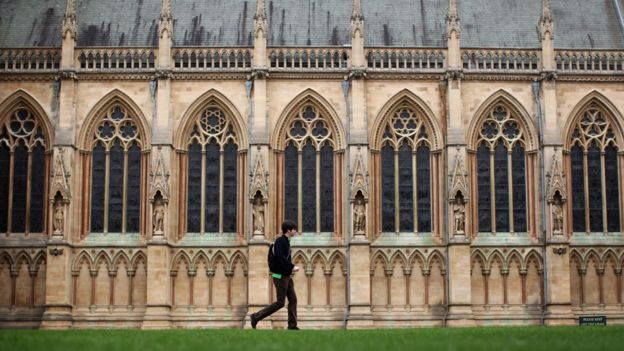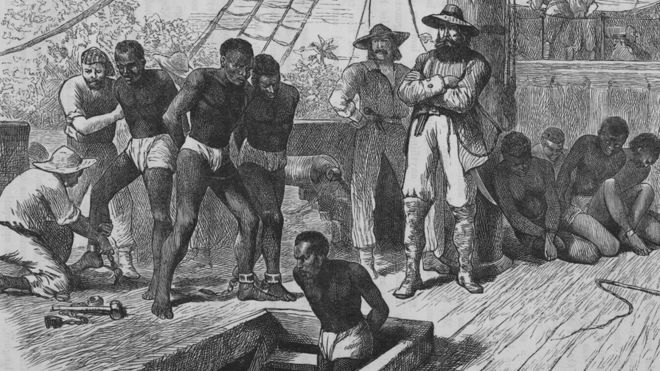Last Survivor of US Slave Ships Discovered, 'Redoshi'; Cambridge Univ. Slavery Links
Last edited Sun May 5, 2019, 08:06 PM - Edit history (1)
- 'Last Survivor of US Slave Ships Discovered,' 'Redoshi' April 3, 2019. The last known survivor of the transatlantic slave ships, brought to the US in 1860, has been identified by an academic at Newcastle University. Sally Smith was kidnapped from West Africa by slave traders and lived until 1937 in Alabama, staying for more than 70 years on the plantation where she had been enslaved.
Hannah Durkin made the discovery in first-hand accounts and census records. The previous last known survivor had been a former slave who died in 1935. Dr Durkin, whose research has been published in the journal Slavery and Abolition, says it almost seems "shocking" that the story is so close to living memory.
Kidnapped at 12: The woman, who was named Sally Smith in the US but had originally been called Redoshi, was kidnapped by slave traders in 1860 from a village in what is now Benin. Dr Durkin believes she was 12 years old when she was transported on one of the last slave ships to go to the US, along with more than 100 other men, women and children. She was bought by an Alabama banker and plantation owner and was given his surname of Smith.
Even though slavery was abolished five years after her arrival in the US, Redoshi remained working on the same estate, living with her husband, who had also been abducted from the same part of West Africa, and their daughter. The researchers say she stayed on that same plantation for more than 70 years after the end of slavery - and was the last known person from the generation who made the enforced crossing from Africa...
MORE, https://www.bbc.com/news/education-47791828 *Wiki, REDOSHI, https://en.wikipedia.org/wiki/Redoshi

- Sally Smith, 'Redoshi' (d. 1937) and her husband (d. 1910s-1920s), date unknown.
_______________________________________________
-'Cambridge Investigates Its Links to Slavery,' BBC, April 30, 2019. The University of Cambridge is to investigate its own historical links with slavery and will examine how it might have gained financially. It has launched a two-year study that will examine its archives to see whether it gained from the slave trade.
Universities have faced questions about the legacy of links to slavery. "It is only right that Cambridge should look into its own exposure to the profits of coerced labour," said vice-chancellor Stephen Toope. "We cannot change the past, but nor should we seek to hide from it," said Prof Toope, who wants the process to help the university "acknowledge its role during that dark phase of human history". An advisory group has been appointed, chaired by Prof Martin Millett and based in the Centre of African Studies, which will examine the university's archives, libraries and museums to find connections with slavery.
"We cannot know at this stage what exactly it will find but it is reasonable to assume that, like many large British institutions during the colonial era, the university will have benefited directly or indirectly," said Prof Millett. The benefits may have been financial or through other gifts. "But the panel is just as interested in the way scholars at the university helped shape public and political opinion, supporting, reinforcing and sometimes contesting racial attitudes which are repugnant in the 21st Century."
It will also consider how the university might make reparation for any links to the legacy of the slave trade - whether in symbolic terms, such as monuments or re-naming buildings, or in funding bursaries or foundations. Prof Millett highlighted that the University of Glasgow is setting up a centre for the study of slavery, after it found that it had received donations in the 18th and 19th Century, derived from slave trade profits, which could be worth up to £198m in present day value. Universities in the UK and the United States have faced scrutiny about whether they had benefited from slavery and coerced labour, particularly during the 18th and 19th Century.
Britain's involvement in the slave trade: British merchants were among the main participants in the Atlantic slave trade, transporting about 3.1 million Africans (of whom 2.7 million survived the journey) to the colonies in the Caribbean, North and South America and to other countries. The three most important ports for British slave traders were London, Bristol and Liverpool...Reflecting the past: Oxford University, Harvard University, Georgetown University...
More, https://www.bbc.com/news/education-48097051

Cambridge will hold a two-year investigation into its links to slavery.

dixiegrrrrl
(60,010 posts)who wrote a book Barracoon. about last slave ship, and a male slave, Kazoola, who she billed as the last slave brought to America, In fact., Hurston had also met Redoshi, in Selma. but did not write about her, for unknown reasons.
both Redoshi and Kossuth ( renamed Cudjo Lewis) were on the same, last ship.
Lewis died 2 years before Redoshi.
i
Sally Smith is actually seen in a video on YouTube, at the 2:38 mark, the film is quite blurry and dark, unfortunately.
Very detailed history of what happened to the last group of slaves, who were brought to a port of Mobile, Al, can be found here.
https://en.wikipedia.org/wiki/Africatown
appalachiablue
(41,131 posts)of Redoshi and the info. I never learned about her, the ship, or Africatown while working at the National Archives, aka 'The Paper Mountain.' The story should be told in 3D, I hope PBS & Henry L. Gates are working on an upcoming program.

- Wolf/DeWolf Family of Bristol, Rhode Island, Slave Traders, James DeWolf
https://www.tracingcenter.org/resources/background/james-dewolf/
Tracing Center. James DeWolf of Bristol, Rhode Island (1764-1837) was a United States senator and a wealthy merchant who, at the time of his death, was reported to be the second richest person in the country. He was also the leading slave trader in the history of the United States. Over fifty years and three generations, from 1769 to 1820, James DeWolf and his extended family brought approximately 12,000 enslaved Africans across the Middle Passage, making the DeWolf1 family our nation’s most successful slave-trading family.
In a notorious incident aboard the slaving ship Polly in 1789, James DeWolf ordered an enslaved woman, dead or dying of smallpox, thrown into the Atlantic Ocean. While there was an attempt later to prosecute him for this act, he was found not guilty, on the grounds that this was his duty as ship’s captain. (See below, “The incident aboard the Polly.”)
- The DeWolf slave trade: The DeWolf family fortune was built on the buying and selling of human beings. DeWolf slave ships brought the enslaved from the west coast of Africa to auction blocks in Charleston, South Carolina and other southern U.S. ports; to Havana, Cuba and to other ports in the Caribbean; to their own sugar plantations in Cuba; and into their own homes. James DeWolf owned a rum distillery, and he and his family started both a bank and an insurance company, all to profit even further from the slave trade. They even sent a family member to establish an auction house in Charleston, S.C., where many of their slaving voyages ended up.
In the 1790s and early 1800s, DeWolf and his brothers virtually built the economy of Bristol, Rhode Island: many of the buildings they funded still stand, and the stained glass windows at St. Michael’s Episcopal Church bear DeWolf names to this day. Across the generations, their family has included state legislators, philanthropists, writers, scholars, and Episcopal bishops and priests.
- Illegal slave trading: The DeWolf family continued in the slave trade despite state and federal laws prohibiting many of their activities in the late 1700s. Their efforts to circumvent those laws eventually lead them to arrange a political favor with President Thomas Jefferson, who agreed to split the federal customs district based in Newport, R.I. This maneuver permitted the appointment of a customs inspector just for Bristol, and the choice was Charles Collins, the brother-in-law of James DeWolf, who conveniently ignored the slave ships moving in and out of harbor.
One member of the family, George DeWolf, is known to have continued in the trade after 1808, when Congress banned the importation of slaves into the U.S. He did so until 1820, when Congress made slave trading a hanging offense. James DeWolf himself was reported to have abandoned the slave trade as of January 1, 1808; there is, as yet, no evidence to demonstrate that he took part in any slaving voyages after that date, but it seems quite possible that he did.
The DeWolf family’s complicity in slavery continued after 1820 in other ways, too, as the family maintained slave plantations in Cuba and James DeWolf invested his slave trade profits in textile mills which used slave-produced cotton.
Today, there are as many as half a million living descendants of the people traded as chattel by the DeWolfs…"